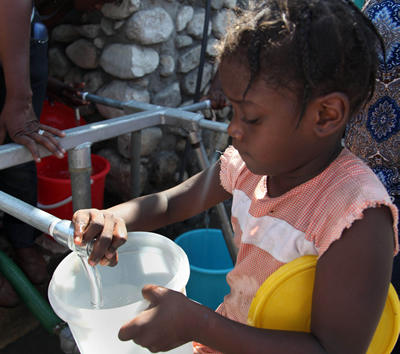Map of Child Poverty among the Region's Indigenous and
Afrodescendent Peoples

|
| Photo: Courtesy UNICEF |
Almost 13 million boys and girls in Latin America (7.3% of the child population) belong to one of the more than 700 indigenous peoples in the region, while another 31 million are Afrodescendents (17.8%), according to a new report produced by ECLAC as part of a joint project with UNICEF on child poverty, inequality and citizenship.
Despite the region's growing concerns over the rights of indigenous and Afrodescendent children, there are no studies or systematic statistics on the deficiencies they face, as stated in the document Pobreza infantil en pueblos indígenas y afrodescendientes de América Latina (Child poverty in the indigenous and Afrodescendent peoples of Latin America), produced by the Latin American and Caribbean Demographic Centre (CELADE)– Population Division of ECLAC.
The study provides ethnically differentiated information for 17 Latin American countries: Argentina, Belize, Bolivia, Brazil, Chile, Colombia, Costa Rica, Ecuador, El Salvador, Guatemala, Honduras, Mexico, Nicaragua, Panama, Paraguay, Peru and Venezuela. For each country, the situation of indigenous children is analysed (and the situation of Afrodescendent children is analysed for the last eight countries).
As well as including demographic data, the research also examines the scale of indigenous and Afrodescendent child poverty by using a multidimensional and direct way of measuring poverty with a human rights approach developed by ECLAC and UNICEF. Rights to education, housing, information, access to drinking water and sanitation facilities were all considered.
The study processed census microdata from databases available in CELADE. Indicators were calculated using the censuses from 2000-2010, mainly using the criterion of ethnic self-identification to facilitate data comparisons.
According to the report, the region's indigenous children are concentrated mainly in Mexico, Peru, Bolivia and Guatemala. Afrodescendent children live mainly in Brazil.
Six in every 10 indigenous children live in rural areas, while seven out of 10 Afrodescendent children live in urban areas. According to the document, given that access to public services and State goods is more limited in rural communities, the poverty situation there is more critical.
The results of the study show that half a million indigenous children (6.3% of those aged between 7 and 18) have never accessed formal education or have left education without successfully passing any year of study. In contrast, only 0.6% of Afrodescendent children and 1.9% of the region's other children are in this situation.
According to the text, the highest proportions of indigenous children with no access to formal education systems are found in Venezuela (17.8%), Colombia (17.1%), Costa Rica (14.8%), Guatemala (15.3%), Honduras (14.3%) and Panama (14.1%). The lowest rates of severe disparity can be seen in Brazil (0.3%), Chile (0.7%), Argentina and Peru (1.4%) and Bolivia (1.6%).
Among indigenous peoples, girls have less access to education than boys. In Afrodescendent peoples and the child population at large, this ratio is reversed.
The results of the study also indicate that nine in 10 indigenous children and eight in 10 Afrodescendent children are deprived of some kind of right to information, which means availability of computers, telephones, televisions and other devices and services depending on the country. Among the rest of the child population, these privations affect six in 10 children.
In addition, 84.2% of indigenous children suffer (moderate and severe) deficiencies in terms of access to decent housing. According to the study, at least eight million indigenous children and almost four million Afrodescendent children live in housing with serious material deprivation and a high level of overcrowding.
Similarly, three in 10 indigenous and Afrodescendent children have no access to drinking water or safe water sources. In absolute terms, this problem affects 3.8 million indigenous children and 7.7 million Afrodescendent children.
This is combined with the fact that over 6.5 million indigenous children and more than 10 million Afrodescendent children do not have sanitation facilities.
The study's recommendations include monitoring implementation of the right to education. For instance, there is a need for: school curriculums to be relevant in indigenous territories and the main areas of historical settlement for Afrodescendents; progress to be made in initial teaching training and specialization in bilingual intercultural education; and the development of appropriate teaching materials.
Lastly, with a view to achieving a better understanding of the situation of indigenous and Afrodescendent children, the report invites countries to devise new measurement methods that link human rights to education, information, housing, drinking water and sanitation facilities with the rights of these peoples to cultural integrity and autonomy.
More
IN FOCUS
Growing Importance of Outsourcing in Latin America and the
Caribbean
Women's Autonomy, Overview of Four of the Region's Countries
ECLAC Promotes Development of Sustainable Cities in the Region through Expert Forum
|
The region's indigenous children are concentrated mainly in Mexico, Peru, Bolivia and Guatemala. Afrodescendent children live mainly in Brazil. |
|
|
|
|
|
According to the study, at least eight million indigenous children and almost four million Afrodescendent children live in housing with serious material deprivation and a high level of overcrowding. |
|